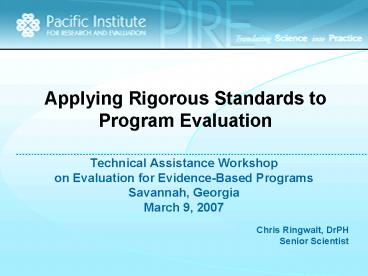Applying Rigorous Standards to Program Evaluation - PowerPoint PPT Presentation
1 / 20
Title:
Applying Rigorous Standards to Program Evaluation
Description:
... one example of a research design. Type of evaluation is indicated by: ... Did you collect your data in a rigorous and defensible fashion? Hierarchy of designs ... – PowerPoint PPT presentation
Number of Views:58
Avg rating:3.0/5.0
Title: Applying Rigorous Standards to Program Evaluation
1
Applying Rigorous Standards to Program Evaluation
- Technical Assistance Workshop
- on Evaluation for Evidence-Based Programs
- Savannah, Georgia
- March 9, 2007
- Chris Ringwalt, DrPH
- Senior Scientist
2
What this presentation is about
- Ensure a common understanding of the evaluation
requirements of the Partnerships and Character
Education Program - Based on the language of the enabling legislation
- What this presentation is not about
- Evaluation 101
3
Whats required of you? (Part I)
- To conduct a comprehensive evaluation of your
program based on a scientific research design - To assess the integration of your program into
your schools classroom instruction and its
consistency with state academic standards - To assess program effects on
- Students (including students with disabilities)
- Teachers
- Administrators
- Parents
- Others
4
Whats required of you (Part II)
- To determine your programs effects on key
elements of character education, such as - Caring
- Civic virtue and citizenship
- Justice and fairness
- Respect
- Responsibility
- Trustworthiness
- Giving
- Other elements pertinent to your program
5
Whats required of you (Part III)
- Factors from which you may select to determine
program effectiveness - Discipline
- Academic achievement
- Participation in extra-curricular activities
- Faculty and administration involvement
- Student and staff morale
- School climate
- Parental and community involvement
6
The next slide displays one example of a research
design
- Type of evaluation is indicated by
- PE Process Evaluation
- OE Outcome Evaluation
- Both types of evaluation are needed
7
(No Transcript)
8
So whats a scientifically-based research
design?
- Guidance from Identifying and
- Implementing Educational Practices
- Supported by Rigorous Evidence
- A User-Friendly Guide
- U.S. Department of Education
- Institute of Education Sciences
- http//www.ed.gov/rschstat/research/pubs/
- rigorousevid/rigorousevid.pdf
9
Well-designed evaluations
- address the questions
- Did your program have the effects desired?
- Are you certain that whatever effects you found
(or didnt find) can be attributed to the
program, and not to something else? - Did you collect your data in a rigorous and
defensible fashion?
10
Hierarchy of designs
- Gold standard Randomized Controlled Trials
(RCTs) - Quasi-experimental designs that use very closely
matched comparison groups - Quasi-experimental designs that use comparison
groups of convenience - Single group designs
11
Now, RCTs only work if you
- Randomize at the right level (student, class, or
entire school) - Can avoid cross-group contamination
- Can secure the cooperation of the individuals or
groups to be randomized - Can prevent any manipulation
- Have enough units of randomization to
- achieve equivalence between groups
- address your research questions (i.e., power)
12
Quasi-experimental designs, however
- Depend on the quality of the match between
intervention and control groups - Are weakened with matches of convenience, which
often fail - May have groups that differ in many ways, both
measurable and unobservable (e.g., motivation to
change) - Require careful adjustments, which only work if
you can adjust on things that matter
13
Some design options for quasi-experimental
designs
- Close matching of schools using all available
data (e.g., from the Common Core of Data _at_
http//nces.ed.gov/ccd/) - Pairwise matching
- Propensity scores
- Comparisons of successive cohorts of students in
a given grade or set of grades - Time series designs that rely on archival
achievement or disciplinary data - Linkage of student survey to achievement data at
individual level
14
Heres what you are doing
15
Here are the types of archival data youre using
(updated 2005 survey)
16
Focusing on . . .
17
Other important things to think about (pages 5-8)
- Describe how you implemented your program.
- Specify chain of logic by which you expect your
program to achieve results. - Check for baseline differences between
intervention and comparison groups. - Use reliable and valid measures.
- Collect data in a consistent and unbiased
fashion. - Minimize loss to follow-up (attrition).
- Report findings for everyone enrolled in the
program, not just those exposed to it. - Conduct analyses appropriate to level of
assignment.
18
More things to think about (pages 9-14)
- Report program effects in plain English.
- Be wary of reporting effects on sub-groups.
- Remember that multiple evaluations with
consistent effects are required to generate
confidence in program effects. - Minimize selection bias in comparison groups.
- Maintain and measure program fidelity.
19
In summary
- RCTs are best, but
- Quasi-experimental designs can be very powerful
tools. - Strength of evidence depends on similarity of
comparison groups. - Outcome evaluations mean nothing without process
evaluations to complement them. - There is no substitute for an evaluation design
carefully specified prior to program
implementation. - Close and ongoing communication between program
directors and evaluators is key.
20
Good work!
- Let me know if youd like to bounce any
- ideas off me.
- I can be reached at
- Phone (919) 265-2613
- E-mail ringwalt_at_pire.org































